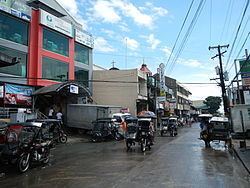Founded 1583 Area 64.51 km² Local time Thursday 1:10 AM Dialling code 49 | Barangays Population 40,049 (2014) | |
 | ||
Demonym(s) Siniloeño/a or Siniloense Weather 26°C, Wind NE at 5 km/h, 96% Humidity Neighborhoods Halayhayin, Llavac, Acevida, Buhay, Mendiola | ||
Siniloan is a second class municipality in the province of Laguna, Philippines. According to the 2010 census, it has a population of 35,363 people. The people call themselves as Siniloeño/a or Siniloense in Filipino.
Contents
- Map of Siniloan Laguna Philippines
- Barangays
- History
- Religion
- Attractions
- Education
- Health
- Utility Services
- Financial Institutions
- References
Map of Siniloan, Laguna, Philippines
Sinilóan lies between the plains of the Sierra Madre Mountains and the Laguna de Bay, bounded between the municipality of Mabitac on the west, Pañguil on the east, Real, Quezon on the North and Laguna de Bay on the South. Fámy which was formerly a small barrio of Sinilóan and known as Barrio Calumpáng was separated from Sinilóan in 1910, while the town Mabitac, also formerly a barrio of Sinilóan, was separated from the town in 1613. A river named Río Romelo runs through the center of the town and is used for fishing ground and irrigation purposes. The town proper or población is about 84 kilometres (52 mi) from Manila, passing Manila East Road or Marcos Highway, and about 113 kilometres (70 mi) via the South Luzon Expressway passing the town of Santa Crúz, the capital of the province.
Sinilóan is a center of education, commerce and transportation, serving towns in eastern Laguna and some towns from the provinces of Quezon and Rizal. The municipality has active business and trade activities.
Barangays
Sinilóan is politically subdivided into 20 barangays. Of these, 13 are classified as urban and 7 are classified as rural.
History
In 1583, Sinilóan came to be as a town. This was the year when Don Juan de Salcedo came to this place and the parish was established jointly by Friar Diégo de Orpesa and Friar Juan de Palencia. The first stone church was erected in 1733 by a Franciscan Friar, Fr. Melchor de San Antonio.
From the early period of Spanish colonialisation, some female inhabitants of the place were milling their palay in their fields. While doing this, some Spaniards came and asked them, "Como se llama esta pueblo?" The natives, not knowing Spanish thought that they were asked what they were doing and one of them answered, "camí po ay gumiguiling". The Spaniards repeated, "Guiling-Guiling", to which the natives nodded. Some this place known as "Guiling-Guiling" from 1583 to 1604.
Another story has it that during the later part of the year 1604, three brothers, namely, Juan Puno, Juan Pili, and Juan Puhuwan, migrated into this community. They selected a lot adjacent to the river Río Romelo and divided it equally among themselves. When the parish priest saw the ingenuity of the three brothers in equally dividing the land, he asked the natives how equally was expressed in Tagalog. The natives gave him the expression "Sinloan". Right then and there, the name Guiling-Guiling was changed to Siniloang which meant justice, equality and fairness. The word travelled from mouth to mouth with sound variations. Because of the difficulty of some Spaniards in pronouncing Siniloang, the name Siniloan struck and became the official name of this town.
The name Siniloan is also believed to have been taken from a legendary story about Luis and Ana, a married couple who chased a wild boar from a place called Luisiana. They ran after that big boar from Luisiana to Cavinti (kapit sa Binti). The people along the way who saw Luis and Ana chasing the boar took pity on them and helped them to catch it. The people chased the boar through the towns of Lumbán, Kalayaan, Loñgos, Paéte, Paquil, and Pañguil until they finally caught the boar in this town by means of the lassoed captivity or Siniloan. Siniloan start on 3 eggs.
Religion
Religion in Sinilóan are major in Roman Catholicism, about 90% of the population, 7% of Protestantism and other Christian religions and 3% Muslim. The patron saint of this town are Saint Peter and Saint Paul (San Pedro y San Pablo) also the Black Nazarene (Nazareno Negro o Cristo Negro) The town feast is celebrated every 29 June each year.
Attractions
Education
Schools:
Health
Siniloan Pioneer General Hospital This is the first hospital to be established in the town of Siniloan, Laguna Philippines. Established in 2010, this 22 bed community hospital is accredited as a level one hospital by the Department of health and is Philhealth accredited.
Utility Services
Siniloan Water District (SIWADI)
Financial Institutions
Banco Laguna, Inc. (A Rural Bank since 1965)
